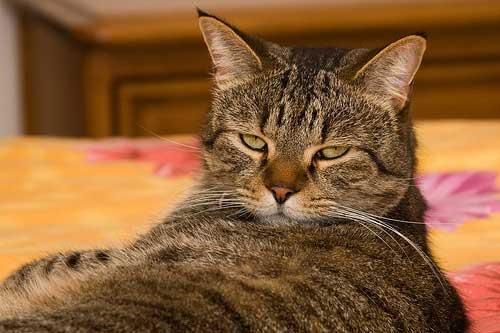
Although the topic of feline anal sacs – commonly called “anal glands” – isn’t glamorous; it is extremely important. If the anal sacs become impacted and infected, cats experience considerable pain and misery.
What are Anal Sacs?
The anal sacs are two small pouches that are located at approximately the four o’clock and eight o’clock position on either side of the anus (see diagram below). The walls of the sac are lined with many sebaceous (oil) and apocrine (sweat) glands which produce a foul-smelling fluid. This fluid is stored within the anal sacs which release its contents through a small duct that opens just inside the anus.
What is the function of the Anal Sacs?

While felines can mark their territory with their anal sacs to leave “messages” for other animals in the same way that dogs and skunks use them; domestic felines generally don’t use them for this purpose. When a cat defecates, the muscular contractions accompanying the bowel movement causes the emission of a small amount of this fluid; giving the feces their distinctive personal- scent signature.
What are the causes of anal sac disorders?
There is no predictable causality for these painful anal sac disorders, according to PetMD. Obstructions or infections causing the overfilling (impaction) and rupture with drainage of the skin around the anus is a common reason why guardians seek veterinary attention for their pet.
Dysfunction of the anal sphincter muscle, enlarged anal sacs that have not been properly compressed by the anal sphincter muscle, excessive secretion from the lining of the anal sac, or constricted or obstructed anal sac ducts may all be at the root of anal sac problems. One of the reasons for this problem is the cat’s stool isn’t sufficiently firm enough to automatically express the anal sacs.
Some cats are just born with very narrow channels leading from the sacs to the edge of the anus. This can cause an obstruction of the flow of material from the anal sac. Additionally, acquired damage to the duct may develop when anal skin infections, inflammation, injury or allergies obstruct the narrow channel that leads from the sac to the surface.
Our kitty, Dr. Hush Puppy was born with very narrow channels. When he was four years old, with no warning or prior indication of a problem, he suffered two episodes of impacted, infected anal sacs. The area close to his anus was swollen and sore. He was licking it constantly, scooting across the floor on his hind end in an attempt to relieve his discomfort, which caused the sac to rupture.
Thankfully, our wonderful feline-only veterinarian did an excellent job treating him. She expressed the sacs, flushed out the solidified material and infused the area with antibiotic ointment. To prevent the area from prematurely closing she inserted a small ring which I turned several times a day, then applying the ointment. Puppy quickly recovered, the ring was finally removed and I continued applying the ointment for several days.
Puppy relapsed a year later, although it’s fairly uncommon for the condition to recur. He was treated identically, however since these two surgeries caused a thinning of the ducts, if the condition recurs, the sacs may have to be surgically removed. While it’s rare that following this surgery that complications occur, unfortunately there is a risk of the procedure causing fecal incontinence in some cats.
Some practioners suggest adding fiber to the diet to prevent this condition, but it is not a panacea. Although by no means is this a pleasant task; your veterinarian can educate you on how to monitor your cat’s anal sacs, to recognize when it’s necessary and how to express them.
What experiences have you had dealing with anal gland problems? Tell us in a comment.
Jo
Photo credits: Top of page: Flickr user: Play4smee. Middle of page: from the http://mypeted.com website who used it under license. If there is a problem please leave a comment and admin will respond quickly.

You know the old saying “You are never too old to learn”? I just learned something which never crossed my mind. Thanks so much for opening my eyes. Great article Jo!!
Very informative, as always! 🙂 Thankfully, I have never (knock wood) had issues with feline anal glands. I have a dog (I know…taboo) who has issues every now and then. But only three times in 9 years. I can handle that. Also, just another little bit of info I have gleaned from the vet…routine expressing (like when the pet is routinely groomed) can actually cause more problems than it solves. Her motto is “if it ain’t broke, don’t fix it.”